 Exotic Reptilian Leathers
Exotic Reptilian Leathers
Alligator and Crocodile Shoes and Boots are some of the most expensive, luxurious items a man can buy.
However, with so many players on the market it is often difficult to separate the scammers versus the quality makers out there.
These exotic leathers have varying properties and characteristics and I am going to help you through the buying process.
In this Guide, expect to learn how to identify the different leathers, what are their characteristics and assess the quality of the hide.
Let’s begin.
There Is No Such Thing As CHeap Alligator & Crocodile
Let’s get this out of the way immediately.
If you want to buy real, high quality luxury shoes or boots from crocodile and alligator you are going to have to spend a lot of money.
The quality of the hide, the origin and age of the animal as well as the species plays a big role.
Something that might not be visible in the beginning, will show as the leather will age horribly.
Of course, if you can find a pre-loved, used and well maintained pair of shoes it can result in a significant cost save.
Then again, if you are looking to buy quality it most likely means that the price point of thousands of dollars is not an issue for you.
However, you still want to buy something good and prestigious and not be fooled.
Commissioning, owning and buying such luxury items should be an experience for you.
I am excited that my own first pair is on the way.
Alligator & Crocodile Price Point


This is because it has way too many variables and some of them include:
- Hide Quality (Grading)
- Species
- Age (of the animal)
- Tannery
- Brand
- Finishing
This means that price points can vary wildly.
Baby crocodile shoes with a belly cut from Enzo Bonafe for example can cost over $3000.
Or choosing the cream of the crop from Paolo Scafora will cost you a mouthwatering $7500.
Even buying some ghastly rubbish from Mezlan (which you should not) will cost you $2000.
Generally, alligator tends to cost more than crocodile but the truly high end crocodiles will cost just as much if not more.
If you see prices below those ranges, it is quite likely that it’s a lower quality shoe or not a premium part of the hide.
Why Do THey Cost So Much?
In short, such animals and their skins are rare and require tremendous effort to produce.
It costs a lot of money to feed those animals, raise them and keep them for years to get the required hides.
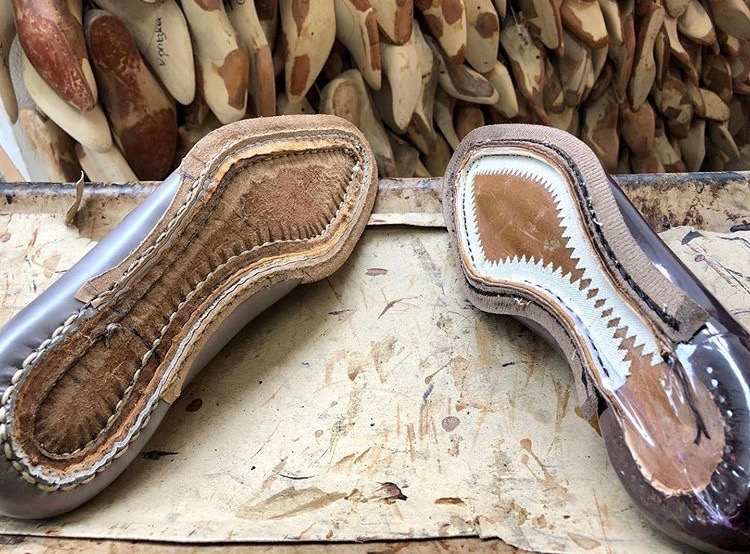

Then, you have the craftsmanship that goes into handmade shoemaking.
A fully handmade shoe can take anywhere between 40 and 80 hours to produce and comes with paying wages.
Lastly, each maker has to make money so there is their margin in there.
Alligator & Crocodile: In-Depth Analysis
Here is the meat of the article (pun intended).
In these subsections we will cover the animals and their differences as well as things to look out for when buying.
Trivia: Florida is the only place in the world where you can encounter both Crocodiles & Alligators!
1. Species
We begin by the main species that you will encounter when buying such exotic shoes.
There are generally four main contenders which come from different regions of the world.
1.1 American Alligator
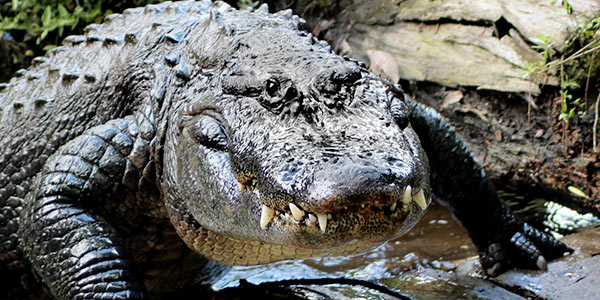


Alligators are reptilians that are native to Southern USA and some regions of China.
Most of the Alligator Leathers come from the American Alligator and only in Florida alone there are more than 1.25 million.
Hermès sources the best alligator leather in the world from the Mississippi river and the Alligator Mississippiensis.
It is a species with symmetrical scales that get progressively smaller outwards.
This less predictable pattern of the scales adds to the character of the leather.
Alligator hides often display the umbilical cord markings which has a defined spiderweb pattern.
1.2 Niloticus Crocodile



The Niloticus Crocodile is native to the Nile River.
This freshwater species can be found around the Nile and some of the best sources come from the Southern tip in Zimbabwe.
It has symmetrical, squarish scales that are slightly larger than the Porosus.
1.3 Porosus Crocodile



The most coveted, expensive and luxurious crocodile species is the Porosus.
Premium hides with symmetrical, small square scale patterns.
It’s called Porosus because it has tiny pores on each scale and it’s an absolutely beautiful animal.
Crocodiles are generally larger than Alligators and the Porosus is truly a big boy!
The Porosus is a saltwater species which you can encounter in the Indo-Pacific regions.
Hermès in particular has farms in Australia.
1.4 Caiman
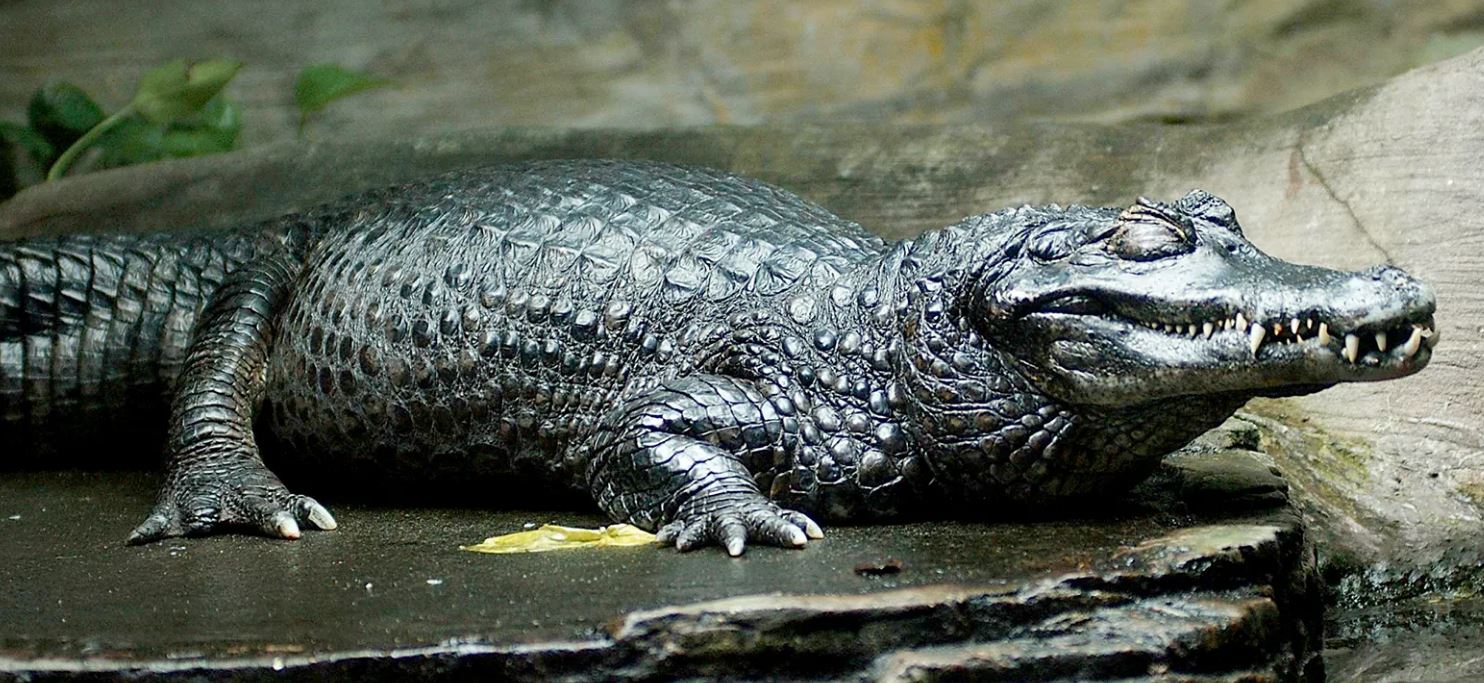


The Caiman is an alligatorid and the cheapest of the bunch.
It’s a smaller relative of alligators and shares quite a lot of traits.
Found in Central and South America, Caimans are the poorest type of Alligator and Crocodile shoes you can buy.
Their leather is not so pliable and is quite bony, making shoes appear cheap and grotesque.
If you have to go with Caiman, I recommend only using it on certain parts of the shoe such as vamps or straps.
2. Alligator & Crocodile Differences
We will now look at a few differences between alligators and crocodiles.
I will not go into too much detail to ensure we stay on track.
2.1 Head Bumps
When you have a whole hide and you are struggling to figure out if it’s alligator or crocodile, just look at the head bumps.
Just count the bumps on the back of the head as their formation hints at the animal species:
- Alligator: 2-2-2
- Crocodile: 4-2
- Caiman: 4-4-2



This is not something you will see on your shoes, but if you inspect some actual hides it is very helpful.
2.2 Scales & Patterns
We touched upon this already, but each animal has their own patterns and scales.
Alligators tend to have a bit more irregular patterns and shapes and become smaller as you go towards the sides.
Crocodiles have tiled, symmetrical square patterns that vary in size (Porosus Vs Niloticus).
The Caiman just sits at the back sad looking at its bony deposits that cannot absorb dye in a good way.
If the color appears distorted or “blotchy” then it’s most likely a caiman.



Alligators also have a distinctive umbilical cord scar with a spider-web appearance.
The Porosus has a tiny dot on each scale that looks like an empty hair follicle.
This pore distinguishes it from the rest.
Both alligator and crocodile belly leathers are soft and pliable, while caiman is stiff and cracks.
Alligator skin is a bit easier to work with when it comes to shoes and leatherworking.
3. Quality Of Alligator & Crocodile Shoes
As with every leather item, the quality can vary not only from species to species but also within the same animal.
The area of the hide, the age and the grading of the actual hide is very important when it comes to the quality.
3.1 Grading
Grading refers to a number or letter that a hide receives to indicate its quality.
In alligator and crocodile hides the grading goes usually between 1-5.
Farmed animals often have a higher standard and quality.
I found a fantastic yet simple explanation from AMTAM (American Tanning Leather).



As you can see you simply divide the hide in quadrants and based on the defects you can assess the grading.
Defects include things such as:
- Healed Scars
- Open Scars/Cuts
- Holes
- Parasites
- Wrinkling
- Wide Umbilical Scars
- Grain Damage
- Bones
Since you can be a bit more selective when making shoes rather than bags that require more symmetry, you can be a bit more flexible with the grading.
While Grade 1/2 is top quality and better suited to larger items, if you have access to it they also make the best shoes.
Grades 2/3 are often used for shoes but it also depends on the location of the defects and the skill of the clicker.
A good pattern maker can make the best out of a hide and ensure symmetry and visual balance.
Because don’t forget, you need multiple hides that have similar patterns and that is already random and very difficult.
3.2 The Belly
Now we are going to one of the most important part of the guide.
Where does the best leather come from?
The underbelly of course.
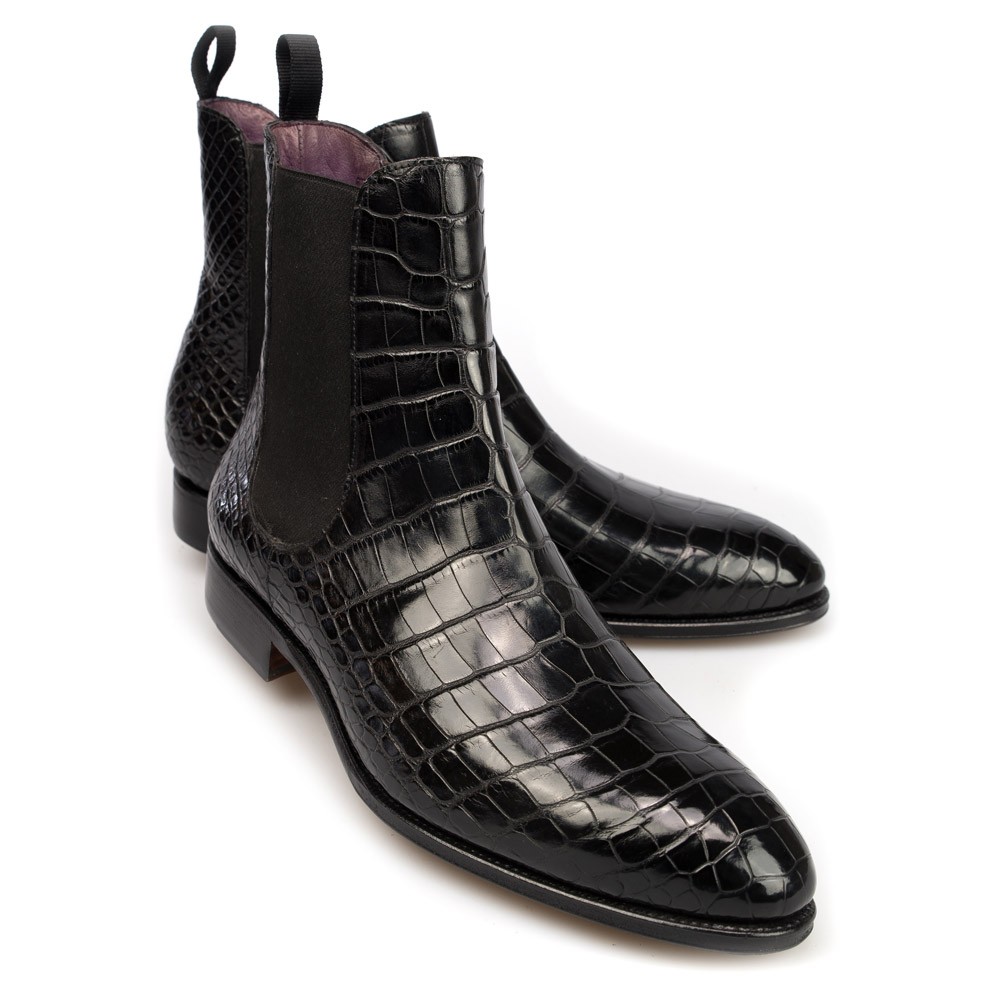


This can be strange at first when you consider that in calfskin the worst part is the belly.
Smooth, soft, pliable and less bony, the underbelly will yield the best and highest quality leathers.
If you are serious about buying alligator or crocodile shoes you should only consider belly cuts.
3.2 The Hornback
Reptilians are vicious predators with also a lot of enemies and harsh conditions and crawl on their belly.
Their back needs to be protected by bony, tough scales.
These scales are extremely bony, tough and look like tiny mountains.
Hornback is cheap, ugly and is the part that most terrible brands will use and say its exotic.
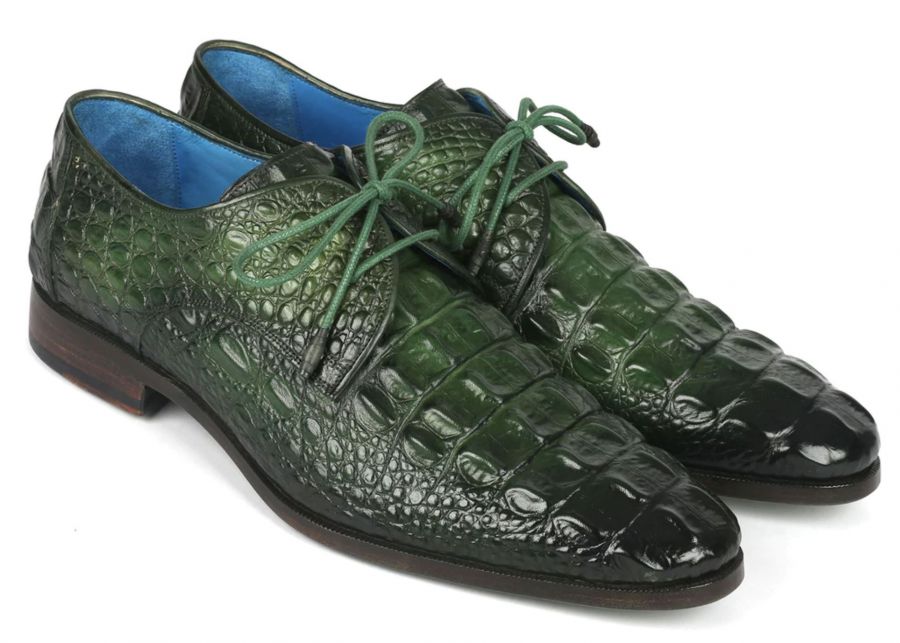


I promise you, some of the worst shoes in the history of the world are made from Hornback.
Absolute disaster.
4. Sizes Of Alligator & Crocodile Hides
Not all of these animals are big and that depends on the species but also their age.
The size of the hide is measured in centimeters at the widest point of the belly.
For shoes and to ensure consistency when it comes to looks, a size of about 40 cm is quite reasonable.
Hides between 25-32 are better for smaller goods while there are also enormous 55+ hides.
5. How To Distinguish Quality Exotic Shoes
It is time to talk about the actual shoes.
There are a few key areas where you need to look at.
5.2 Scales Pattern & Hide



One of the first things to do is visually look at the type of hide.
If it is bony, just like the “specimen” above then you know you are dealing with Hornback and that is a no-no.
Look for uniformity in the scales and pattern making.
Someone worked hard to find hides with same visual elements to make shoes and boots that match.
Look at the sides and the small details that showcase if the pattern was cut in similar areas.
5.3 The Model



While fashion and design can be subjective, a shoe can speak without speaking.
All you have to do is look at the proportions, model design and toe shape.
Shoes with high toe spring are usually low quality, with grotesque and blunt square toes.
A really good shoe with have a careful balance on the last, the stitching, the height of the heel for example.
5.4 Construction
Avoiding fashion and designer brands when it comes to quality shoes is imperative.
They might use the best leather in the world, but the construction could be cheap and basic.
Would you spend thousands of dollars on a non-recraftable shoe or would you rather enjoy the journey and knowledge that someone spent 80 hours making your pair by hand?
Buy from established heritage brands, which I will list later.
Tip: Learn more about shoe construction here.
5.5 Price
While price is not an indicator of quality, it can be an indicator of the opposite.
If you find shoes that cost too low, they are either a scam, use poor quality leather or are embossed calf.
Seriously, if you see someone writing croco for example it is a faux pattern embossed on regular calf.
If you have thousands to spend, at least make sure you spend it on the correct products.
6. Leather Finish
The last topic I will touch upon is the finishing of the hide.
There are different tanning methods but the most common ones are:
- Matte: Self Explanatory
- Glossy: Glazed, shiny finish
- Nubuck: Sueded, softer nap finish.
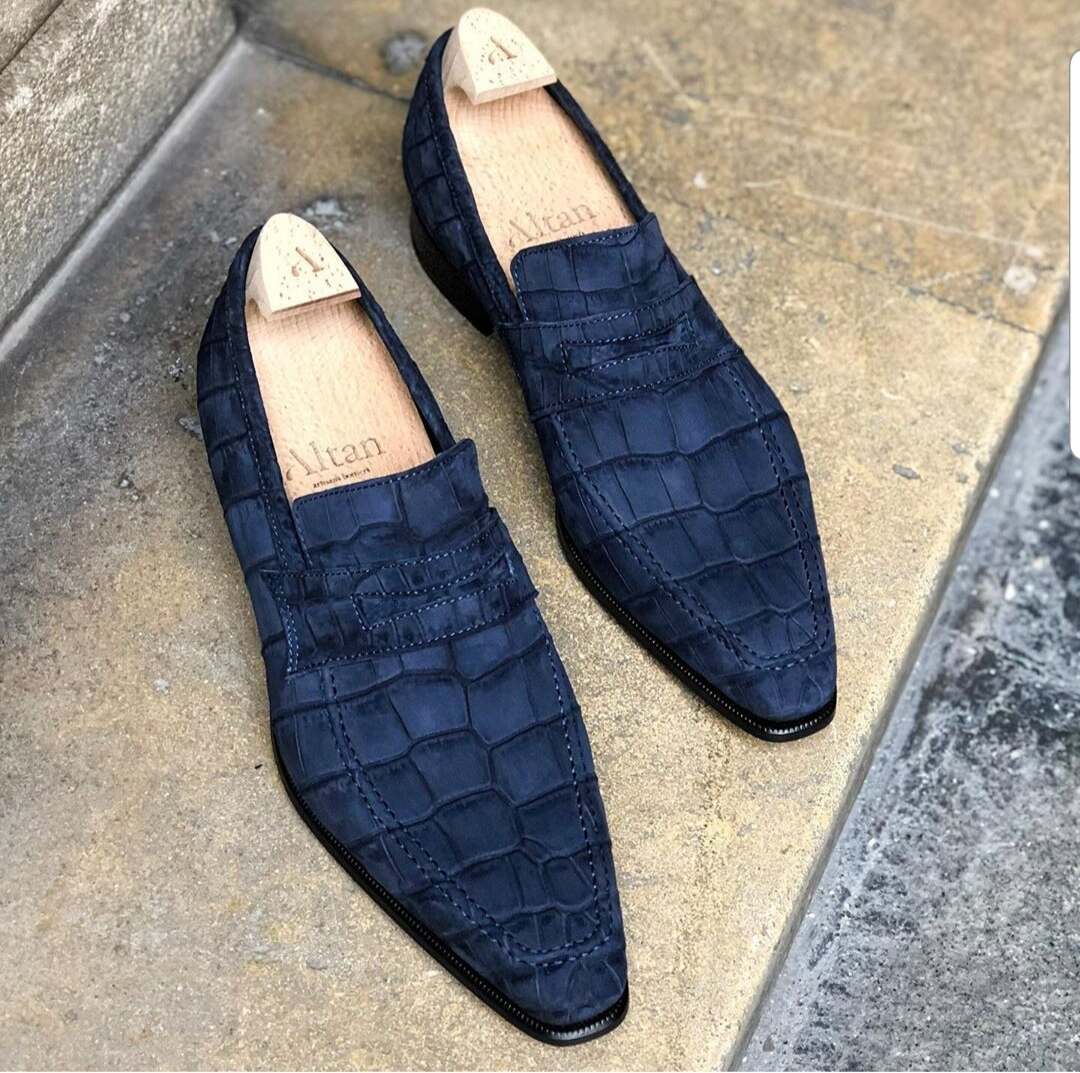


My dream pair is nubuck alligator or crocodile.
It is an absolutely fantastic type of leather.
Exotic Animal Conservation & Protection
We finish up with an important topic that can cause confusion and that is the protection and preservation of exotic animals.
Most exotic animals are protected by the Convention on International Trade in Endangered Species of Wild Fauna and Flora (CITES).
They heavily regulate trade, farming and animal usage depending on how endangered they are.
For certain animals such as Hippos or Elephants for example, they have to die from natural causes in order allow for processing their skin.
These also come with strict paperwork that shows the entire journey of the hide, including certificates and registrations.
Alligators and Crocodiles are legally farmed for their skin and while still in a protected status, are in a much more stable condition.
However, not everything is rosy and especially in Asia many unregulated farms treat these majestic animals terribly.
It is of the utmost importance that if you choose to buy such exotic shoes and materials to do it from a reputable tannery source.
Best Brands For Alligator & Crocodile Shoes
This is the last section and one that is probably the only one you need to know if you want to buy such shoes.
It warrants an entire article of its own with in-depth analysis but I will instead make a shorter list.
1. Graziat Taipei
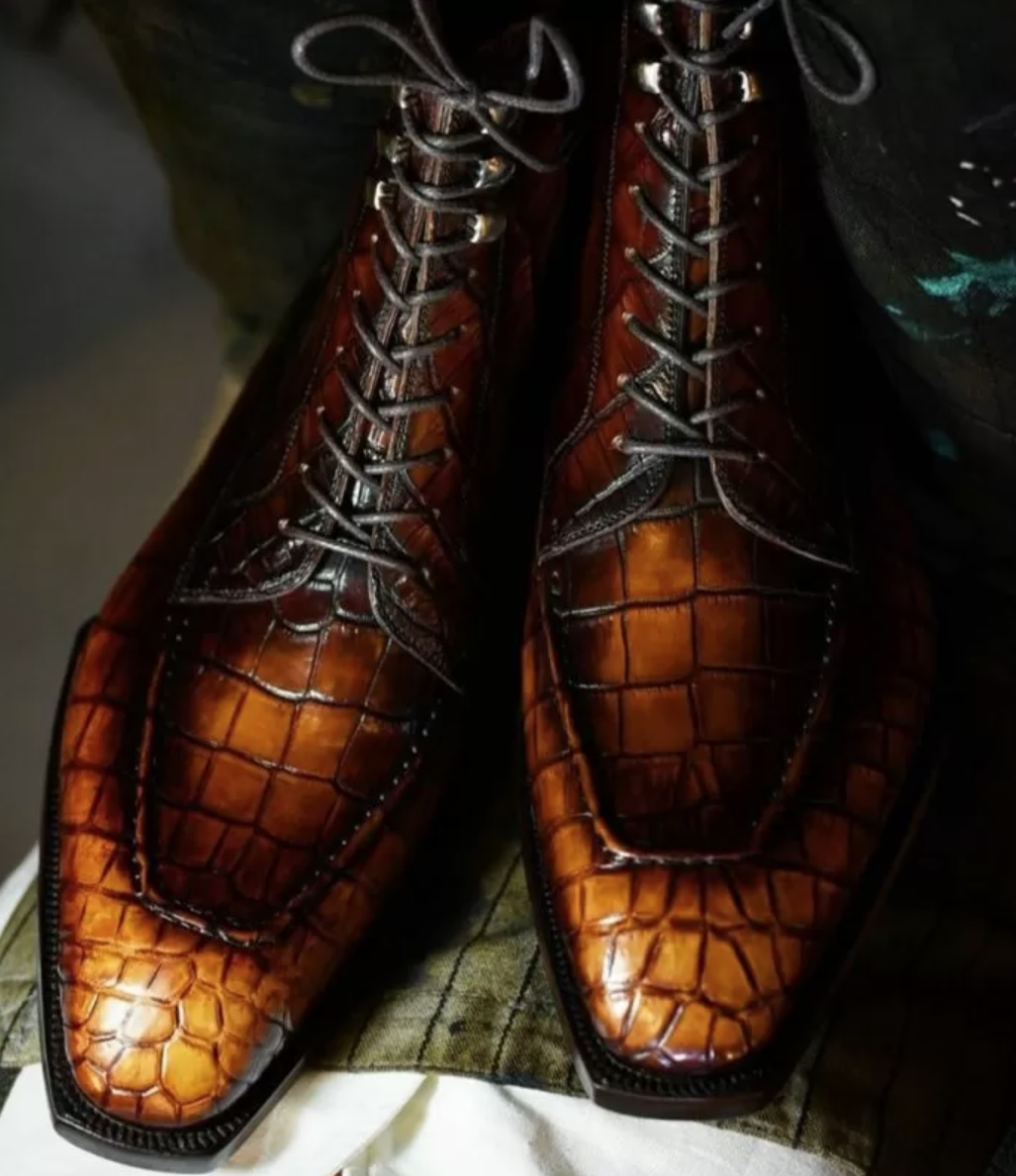

Based in Taipei (Taiwan) and specializing in patinas and the most unique and prestigious designs.
Expect to pay $4000-$6000 on a pair of shoes.
2. Paolo Scafora
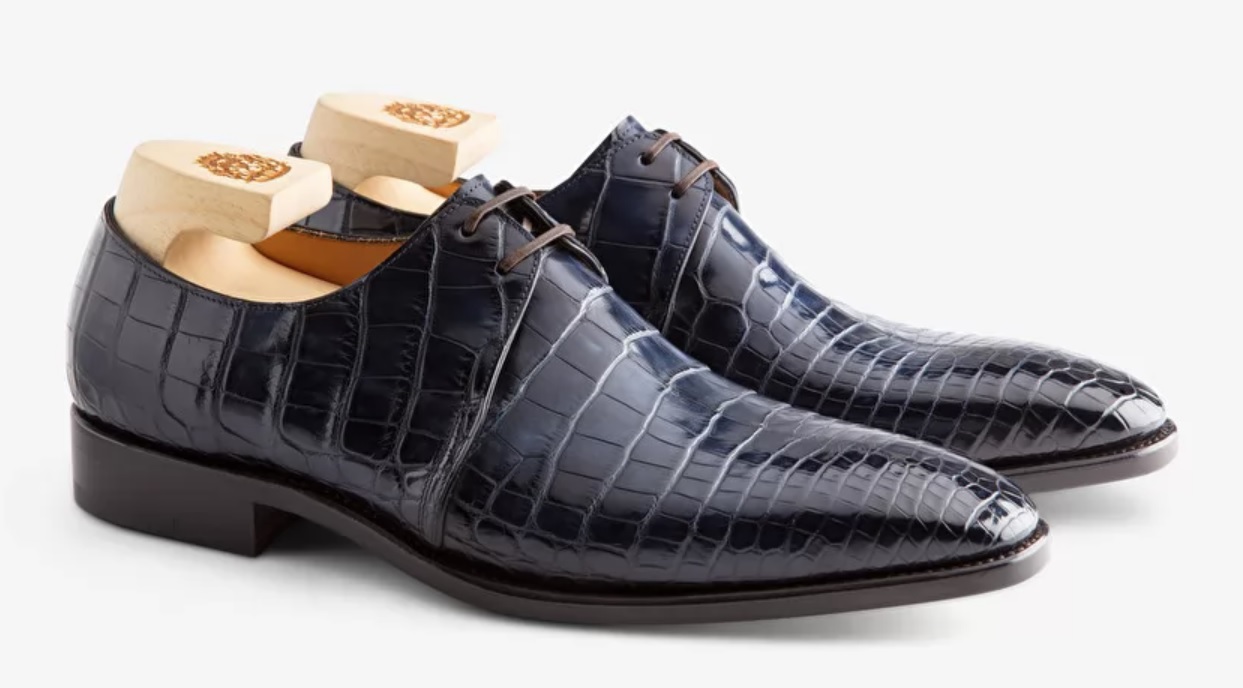


My favorite shoemaker in the world when it comes to design, innovation and balance is Paolo Scafora from Italy.
He raises the bar with his designs and uses the best alligator hides in the world.
Genuinely handmade shoes with the most complex, beautiful constructions out there.
For a Made To Order Pair expect to pay anywhere between $6500 and $10000.
If you wish to commission such a pair, I will be glad to help you as he is a close friend of mine.
Read more about Paolo Scafora at The Noble Shoe.
3. Altan Bottier



Altan Bottier from France is the king of flamboyance and exotics in Europe.
They have a selection of “Ultimate” exotic leathers and are no strangers to working with alligator and crocodile.
I recommend checking them out and you can even read a review here.
4. Enzo Bonafe Bologna


They can also work with baby crocodile leather and much more through their flexible MTO Program.
At about $3000-$4000 is a more affordable option.
5. Stefano Bemer
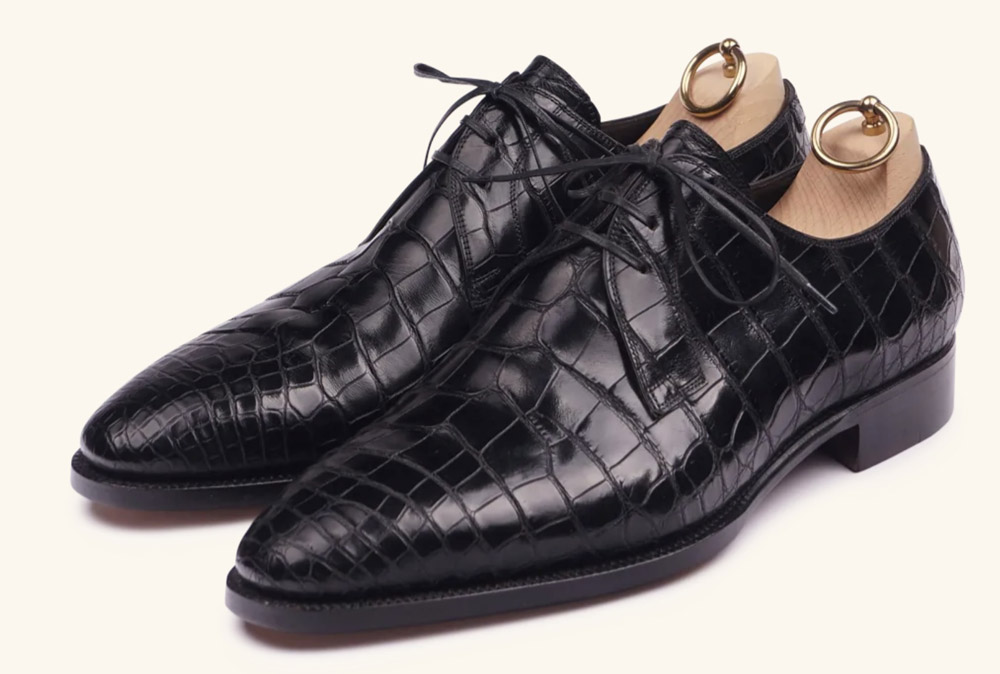

I learned Bespoke Shoemaking there and it should say enough about their quality.
Absolutely top tier shoes in both construction and quality.
A shoe would cost you north of $6000.
6. Carmina
A brand from Mallorca, Spain.
Carmina needs no introduction to shoe afficionados around the world.
They also make some pretty good alligator shoes and boots, such as the one I showed you above in the Belly Subsection.
Driving shoes can start as low as $2000 and go all the way up to $3500.
7. Gaziano & Girling
The only UK entry that I will include is Gaziano & Girling.
Fantastic shoes, though they recently lost my undying support after smiling alongside Andrew Tate.
Beautiful shapes, lasts and materials and they come with a price to match.
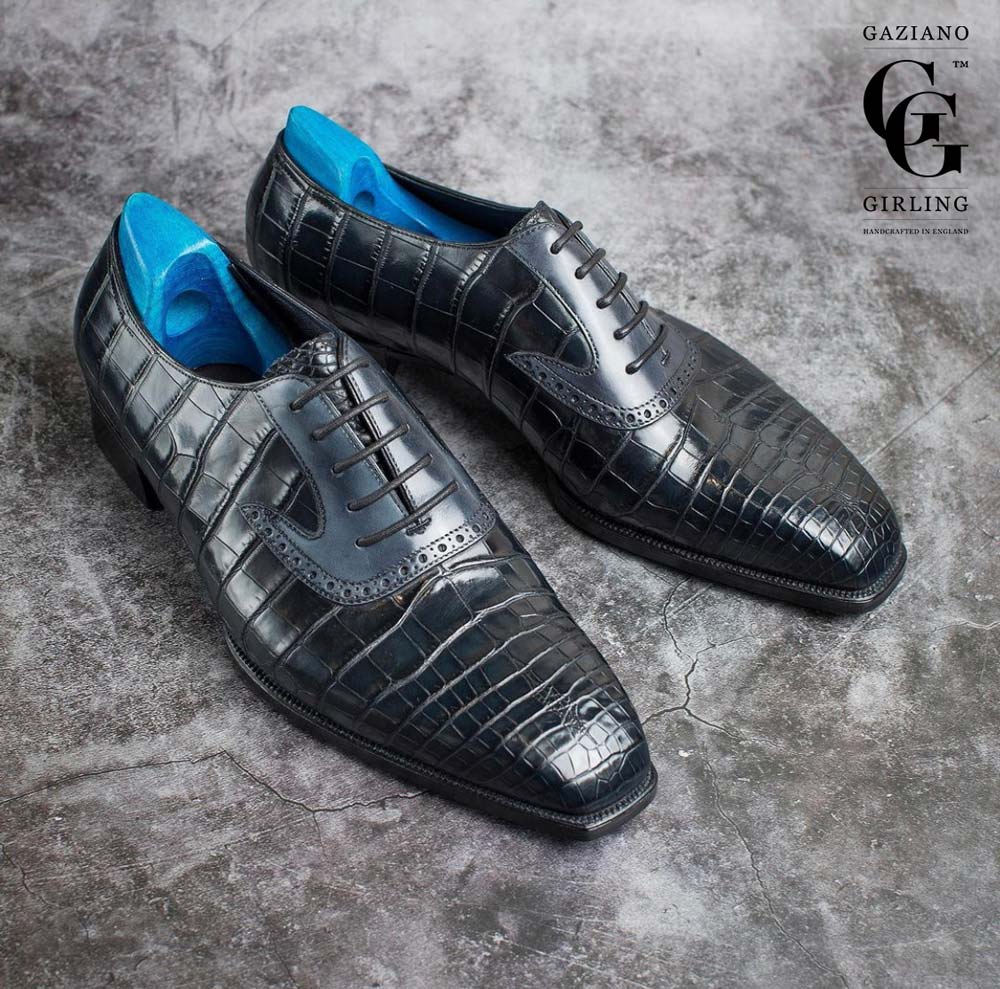


8. Antonio Meccariello
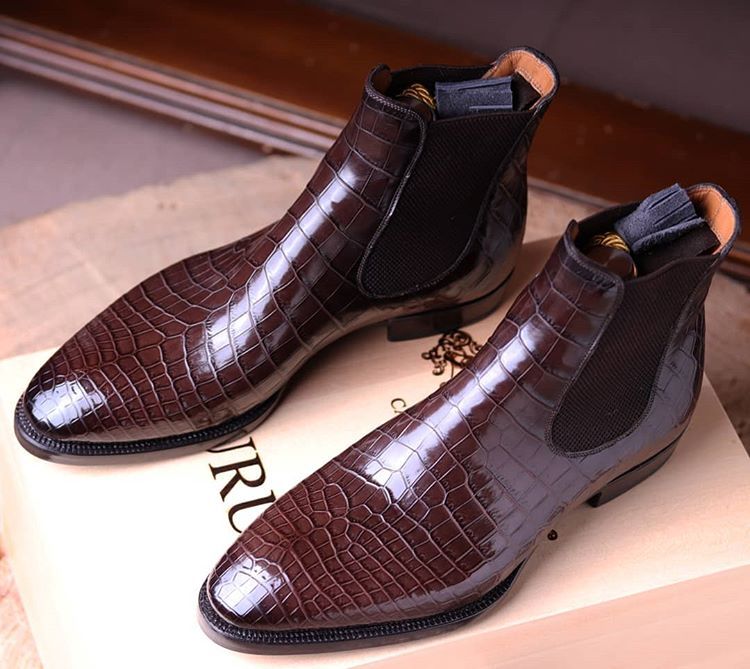


Another master from Naples, Italy that needs no introduction.
Astonishing shoes and one of the best I have ever seen.
I prefer letting the images do the talking.
His website is a hassle, but it’s worth it.
Brands To Avoid & Last Tips
Above you can only find a few of the brands I consider worthy.
There are many, many more makers out there that I did not include.
For a more budget version, you can look at CNES or Vass Budapest’s bi-material offerings.
I recommend avoiding certain brands however:
- Any Designer Fashion Brand: They are overpriced rubbish
- Silvano Lattanzi: Absolutely hilariously overpriced ugly garbage
- George Cleverley: Quality might be good, but the service and execution is terrible
- Mezlan: Even saying the name makes me want to puke
- Paul Parkman: The designs speak for themselves
Be a smart buyer and do at least some research before you spend your money.
If you don’t like shopping, reach out to a qualified store that will offer you a luxury experience and take care of you.
For example, just send me an email at [email protected] and I will take care of you like nobody else has before.
Life is too short for boring, mundane and badly made shoes.
Final Thoughts
This brings me to the end of another gigantic article that was supposed to be short.
But I think it was an important topic to talk about, both for the ethical part of the industry and also to educate you on certain topics.
Spend a little more time to understand where your hard earned dollars will go and give yourselves a gift that will last for a lifetime.
For the rest of us mortals, there are cheaper but equally impressive exotic leathers or beautiful smooth calfskin.
I will see you next week or in the comments!
Thank you for reading,
Kostas Mandilaris,
Misiu Academy



Hi nice information to know about Ali shoe thanks
What about Maui, are they a good shoe,I’ve seen some of the prices around a grand or more? I can be reached at [email protected]. Thanks, in advance.
Hi jack, there is no such thing as 1000 USD exotics of really good quality.
[…] to elevate your footwear game? Look no further than crocodile shoes. These luxurious and sophisticated shoes are a must-have for fashion-forward […]